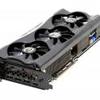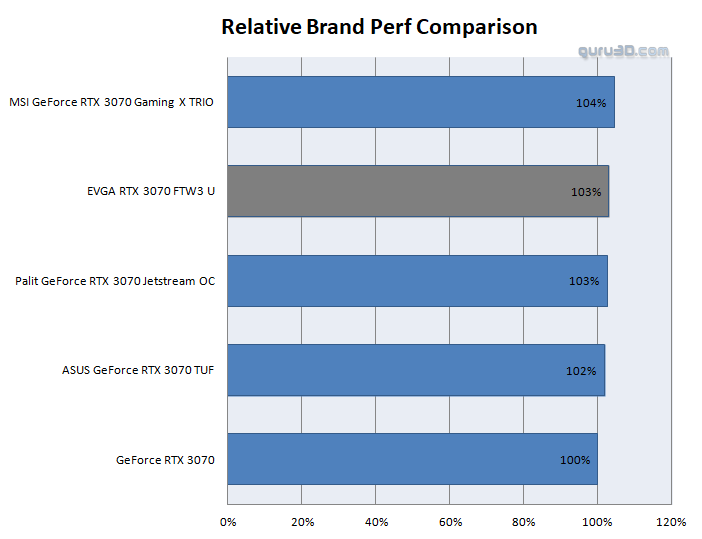Final words and conclusion
Final words
The ULTRA Edition of the FTW3 in its default configuration is not that far away from reference founder edition game performance. Realistically we are looking at performance differentials of 2% performance running up-to maybe 3% in the more GPU stressed situation (measured from founder edition as baseline). The card however does shine once you start to tweak it as there you'll be able to hit close to 2100 MHz on the boost frequency. Albeit a subjective statement, the card is charming on the eyes. Nice to see is a dual BIOS, which is handy as fail-save as well as switching and choosing in between the default and OC mode. Unfortunately, the OC BIOS mode does not yield significant performance at all. My advice to EVGA would be to allow a bit more power allowance on that mode as both modes we measure to sit at 260~270 Watt. Tweaked you can add 11% to that value closer to 290 Watts. Also, we'd advise EVGA to create a silent mode to cater to the audio purists, but we'll address that in a separate chapter though. With the RTX 3070; 1250 USD graphics card series performance should be attainable at (what should be) 500 USD, granted it has less memory, but throughout the benchmark suite, you can see that the RTX 3070 really is battling last-gen's flagship product, the RTX 2080 Ti. However you have seen the gradual price increases ... 679 USD is what you need to pay for this product in the FTW3 Ultra form, and that really steep. And let me also state, not related to any EVGA policy, it's the shortages, trade war tariffs so on. All brands are affected by the conundrum.
My most prominent criticism for the 3070 (in general) however is its 8GB of graphics memory as yes, this still is a proper Ultra HD card. While you'll be fine in Full HD and Wide Quad HD at 8GB, for Ultra HD we feel framebuffer sizes do need to go up. Then again, if this card had 16GB as opposed to its 8GB of GDDR6, then you could easily add close to a 150 maybe 200 USD premium on top of the 500 USD asking price, as yes graphics memory is very one of the most expensive things in that bill of materials for a manufacturer. With that in mind, a 3080 would then be the more logical choice. With that said and done, I get why NVIDIA opted for 8GB, the reasoning behind 8GB as for most games that will be sufficient and keeps that bill of materials used at that a level we ll can embrace.
Performance
Ultimately everything and anything it's all about gaming price, performance, and, of course, rendering quality. Of course, the GeForce RTX 3070 is a product that meets all these factors in a proper way, while we do feel the RTX 3080 offers more value for money, the RTX 3070 simply is more reachable for a bigger crowd (money-wise). This card is capable of running games at 4K, it will serve best at WQHD and extremely GPU bound games. At Full HD you'll be quite often bottlenecked and CPU limited as again, this is 2080 Ti level performance. Performance-wise we can safely state that for future gaming this is a true Quad HD graphics card that is very Ultra HD capable with the current games. But whether or not you use traditional rendering or games that can be ray-traced and manage DLSS, this combo comes together in that WQHD and UHD resolution. Battlefield V with ray-tracing and DLSS enabled, in Ultra HD now running in a ~55 FPS bracket. DX-R ray-tracing and Tensor performance; the RTX 30 series has received new Tensor and RT cores. So don't let the actual RT and Tensor core count confuse you. They're located close inside that rendering engine, they became more efficient and that shows. If we look at an RTX 2080 with Port Royale, we will hit almost 30 FPS. The RTX 3070 passes that at over 38 FPS. Tensor cores are harder to measure, but overall from what we have seen, it's all in good balance, better than the 2000 series for sure. Overall though, the GeForce RTX 3070 starts to make sense starting at a Quad HD resolution (2560x1440) being ultra HD capable, it is that simple. Games like Red Dead Redemption 2 will make you trigger happy at close to 50 FPS in UHD resolutions with the very best graphics settings. As always, comparing apples and oranges, the performance results vary here and there as each architecture offers advantages and disadvantages in certain game render workloads.
Compared to the other 3070 cards we have tested we have to admit, it paints a very similar picture with 2 to 4% performance differentials throughout the lineup tested.
Compute performance
We could easily add an extra section for compute performance, as content creation remains baffling to me with the Ampere series. Not necessarily comparing 3070, to 3080 and 3090, but the step from last-gen series 20 towards series 30 has been nothing short of amazing. The RTX 3070 a good notch faster than an RTX 2080 and still faster than the RTX 2080 Ti. As you have been able to see, the content creation scene is gonna be happy with the Ampere architecture overall as well, applications like Blender and VRAY tear a new hole in performance, absolutely staggering to see and observe. What need I say and state more about performance, you have all the evidence you need in our extensive benchmark suite.
Cooling & noise levels
Depending on the level of airflow inside your chassis, expect the card to sit just under 60 Degrees C range temperature-wise under hefty load conditions, which is just tremendously great for a card of this caliber. The differential in between OC and default BIOS mode was 2 Degrees C. Acoustics however is something we need to discuss, the card hits 37~38 DBa at either BIOS mode, normally that is a value that is okay. However there is something ominous with the cooler that I cannot put my finger on, you can hear it, all the time. Not loud, but it certainly is there. Important to point out, in OC BIOS mode, fan-stop did not kick in (however at BIOS mode that does work). So in OC mode you will hear the card all the time. With such cool temperatures overall, we'd strongly advise EVGA to setup dual-BIOS in a silent and then a performance BIOS mode. There is plenty of room left to tweak with that based on temperatures, and acoustics have become such an important factor these days.
Energy
In the previous paragraph, I already mentioned this; your heat output and energy consumption are always closely related to each other as (graphics) processors and heat can be perceived as a 1:1 state, 200 Watts in (consumption) often equals 200 Watts of heat as output. This is the basis of TDP. NVIDIA is listing their TGP (not TDP) at 220 Watts, which is okay for a graphics card in the year 2020. The FTW3 Ultra at defaults has a little more power allowance, we measure the power draw at gaming load to be 260 Watt. When you open up the power limiter that would be 280~290 Watts.
Coil whine
The GeForce RTX 3070 exhibits only very low levels of coil squeal, EVGA scores good here. It's at a level you can hardly hear it. In a closed chassis, that noise would fade away in the background. However, with an open chassis, you can hear coil whine/squeal. Graphics cards all make this in some sort of form, especially at high framerates this can be perceived.
Tweaking
The card tweaks well. At defaults, the GPU hits the power limiter pretty much constantly, so that's your first and quickest option to tweak. You get 11% extra on the card's default power budget. The clock frequency can take a good 110 MHz extra on the boost frequency as well. Apply these two and you'll see the GPU boost clock hovering in the 2060~2100 domain (frequencies vary per game title as they are dynamic). The memory could be tweaked to 16 Gbps, so all in all these are terrific values bringing 8% additional performance on stringent GPU situation, measured from founder edition level performance.
Conclusion
When the 3070 from EVGA arrived I was like 'yikes, that's going to be a difficult conclusion'. Problem is that new trade tariffs have just been implemented, next to that there is a massive component shortage and of course shortages mean inflated prices. The product can be purchased at the EVGA website for $679, here in the EU a quick lookup reveals that the price to sit in a € 749,- region. Meanwhile, the original MSRP for the founder edition card sits at 499 USD. And that just creates a huge dilemma as it's just too much? If you care to purchase one, please try as much as you can to purchase it directly from the manufacturers though, as etailers understand how the market works, and will even further increase that price.
So with the pricing discussed and out of the way, let's talk about the product itself. In terms of build quality we cannot complain, this is a solid product with reliable components and power design setup in 12+2 phases; which is plenty. The looks are dainty, but that would be subjective as taste differs. The cooling performance is really good, so good that a dual BIOS, I would have preferred a silent BIOS mode as the capacity is certainly there. At default BIOS mode, you will hear this card. Performance-wise, with catchphrases like FTW (for the win), Ultra and so on you'd expect extreme performance. The reality is that NVIDIA rules and regulates everything, including what AIB may do here. So all 'factory tweaked card these days sit roughly at the 2~4% additional performance bracket; back in the days, you could hit 10% with a factory tweaked SKU. Yes, on an average of 100 FPS that literally is 2 to 4 FPS faster/slower. Now we can argue about the nature and choice of an 8GB GDDR6 framebuffer, but in most use cases it's enough and we understand the choice made here, NVIDIA wanted to keep that bill of materials healthy. With future games in mind, this will turn out to become a WQHD (2560x1440) resolution card, and with current games, you can quite easily play Ultra HD games, in that domain, it shines whether that is using shading (regular rendered games) or when using hybrid ray-tracing + DLSS as that combo will offer a very decent performance. The performance you gain from any 3070 graphics card of course is nice, but only if it would sit in that 500 bucks marker. Overall you'll run 3 to 4% faster than founder edition performance, but when tweaked you can further extend that. Aside from my remarks and pointers, we can recommend the card, however, with the current price level going further upwards opposed to downwards it's a hard sell. That comment has very little to do with what EVGA has produced and is offering here. It's not that the product doesn't deserve a recommended award, it's just that we have a very hard time justify pricing at the time of writing. So the award is based on hardware, design, tweaking potential etc, but not pricing ... Capiche?
Sign up to receive a notification when we publish a new article.
Or go back to Guru3D's front page
- Hilbert, LOAD"*",8,1.




